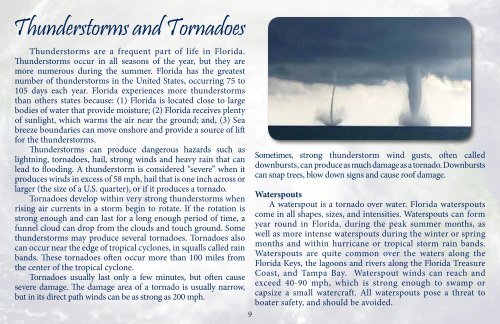2015 Guide
2015 Guide
2015 Guide
Create successful ePaper yourself
Turn your PDF publications into a flip-book with our unique Google optimized e-Paper software.
Thunderstorms and Tornadoes<br />
Thunderstorms are a frequent part of life in Florida.<br />
Thunderstorms occur in all seasons of the year, but they are<br />
more numerous during the summer. Florida has the greatest<br />
number of thunderstorms in the United States, occurring 75 to<br />
105 days each year. Florida experiences more thunderstorms<br />
than others states because: (1) Florida is located close to large<br />
bodies of water that provide moisture; (2) Florida receives plenty<br />
of sunlight, which warms the air near the ground; and, (3) Sea<br />
breeze boundaries can move onshore and provide a source of lift<br />
for the thunderstorms.<br />
Thunderstorms can produce dangerous hazards such as<br />
lightning, tornadoes, hail, strong winds and heavy rain that can<br />
lead to flooding. A thunderstorm is considered “severe” when it<br />
produces winds in excess of 58 mph, hail that is one inch across or<br />
larger (the size of a U.S. quarter), or if it produces a tornado.<br />
Tornadoes develop within very strong thunderstorms when<br />
rising air currents in a storm begin to rotate. If the rotation is<br />
strong enough and can last for a long enough period of time, a<br />
funnel cloud can drop from the clouds and touch ground. Some<br />
thunderstorms may produce several tornadoes. Tornadoes also<br />
can occur near the edge of tropical cyclones, in squalls called rain<br />
bands. These tornadoes often occur more than 100 miles from<br />
the center of the tropical cyclone.<br />
Tornadoes usually last only a few minutes, but often cause<br />
severe damage. The damage area of a tornado is usually narrow,<br />
but in its direct path winds can be as strong as 200 mph.<br />
9<br />
Sometimes, strong thunderstorm wind gusts, often called<br />
downbursts, can produce as much damage as a tornado. Downbursts<br />
can snap trees, blow down signs and cause roof damage.<br />
Waterspouts<br />
A waterspout is a tornado over water. Florida waterspouts<br />
come in all shapes, sizes, and intensities. Waterspouts can form<br />
year round in Florida, during the peak summer months, as<br />
well as more intense waterspouts during the winter or spring<br />
months and within hurricane or tropical storm rain bands.<br />
Waterspouts are quite common over the waters along the<br />
Florida Keys, the lagoons and rivers along the Florida Treasure<br />
Coast, and Tampa Bay. Waterspout winds can reach and<br />
exceed 40-90 mph, which is strong enough to swamp or<br />
capsize a small watercraft. All waterspouts pose a threat to<br />
boater safety, and should be avoided.


